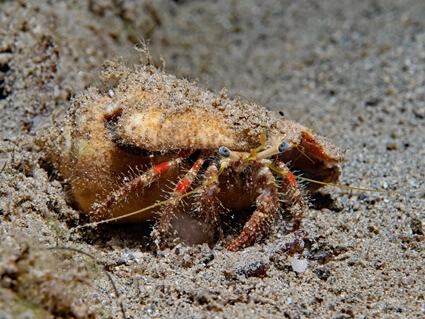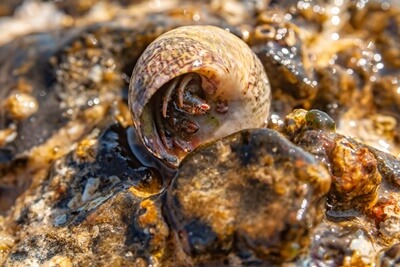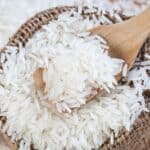Last Updated on July 25, 2023 by Joanne Harper
Wild hermit crabs are scavengers that live on beaches, so seaweed is a natural part of their diet. Seaweed comprises millions of microscopic marine algae that are incredibly healthy for hermit crabs.
Seaweed is usually green, red, or brown. Each color has a different nutritional composition, but all are edible. The most popular edible seaweed are nori, caulerpa, sargassum, dulse, wakame, and kombu.
Edible seaweed helps hermit crabs maintain a robust exoskeleton due to its high calcium content, while the fiber in seaweed supports healthy digestion and digestive transit.
Seaweed is also rich in Vitamins A, B12, C, D3, and E but can be high in heavy metals like zinc and iron.
Hermit crabs can be fed fresh seaweed gathered from a beach if you’re confident it’s not contaminated. A safer alternative is to offer hermit crabs organic, store-bought dried seaweed.
What Is Seaweed?
Seaweed is the colloquial term for marine algae found on the beach during low tide.
Despite the name, seaweed isn’t a nuisance to organic agriculture. Seaweed is considered an essential part of the marine ecosystem.
Seaweed is anchored to the ocean floor, providing food and shelter for aquatic animals.
Over time, seaweed is loosened and washes onto the shore, where it remains until eaten, collected, or returned to the ocean following a high tide.
Do Hermit Crabs Like Seaweed?
When keeping hermit crabs as pets, aim to replicate their wild environment as much as possible.
Hermit crabs live on beaches until captured, interacting with seaweed that washes onto the shore. Seaweed has nutritional benefits, so hermit crabs relish eating it in captivity.
As per the Journal of Applied Phycology, seaweed also encourages the growth of plants and deters common parasitic pests that adversely affect the lives of hermit crabs, like mites.

What Are The Different Types of Seaweed?
Seaweed is a very broad term that comprises thousands of disparate life forms.
Different corners of the globe are home to varying types of seaweed, depending on the climate, water quality, and needs of native aquatic life.
Seaweed is usually identified by its color, with most seaweed appearing green, brown, or red.
Here are the three distinct types of algae and their unique qualities:
Green Seaweed (Chlorophytes)
Green is the color most commonly associated with seaweed on beaches. However, green seaweed isn’t necessarily more nutritious or appealing than brown or red seaweed.
Caulerpa (umibudo or sea grapes) is the most popular and nutritious edible green seaweed.
This seaweed is sometimes referred to as green caviar, primarily due to the texture of the seaweed, which comprises a cluster of green bubbles.
The taste of caulerpa is equally distinctive and may not appeal to every hermit crab palate.
This seaweed uniquely combines salty, sweet, and acidic taste sensations. If pet hermit crabs develop a taste for caulerpa, they’ll enjoy many nutritional benefits.
Brown Seaweed (Phaeophytes)
In the U.S., the most populous form of brown seaweed is sargassum, a common sight on the beaches of Florida – home to many domestic hermit crabs.
Sargassum is also common in the Caribbean, where the Journal of Global Health warns that it impacts the health of locals and tourists by releasing ammonia and hydrogen sulfide gas, usually after washing up on shore for 48 hours or longer.
While this may leave you wary of sargassum, it should be noted that it’s among the most nutritious and popular varieties, acting as a cornerstone of the diet of many wild hermit crabs.
Wakame is another common brown seaweed. Wakame is kelp and is often served in salads and soup by Asian restaurants, so it’s comparatively easy to source. Hermit crabs like the sweet flavor of wakame.
Kombu is another brown seaweed that’s commercially available and hermit crab-safe, although this seaweed should be offered more sparingly. Kombu has high levels of monosodium glutamate (MSG).

Red Seaweed (Rhodophytes)
The most popular edible seaweed is nori (red seaweed). Nori is the seaweed used to wrap sushi rolls and takes on its green appearance due to processing as the seaweed takes on its flat, paper-like shape.
In its purest form, nori is a superfood for hermit crabs. It contains many vitamins and minerals and is a good protein source. Naturally, it also appeals to hermit crabs’ palette.
Dulse is another popular red seaweed. While it resembles lettuce in its natural form, it’s usually sold in flakes by health food stores. Dulse has a smoky, savory scent and flavor similar to bacon.
Can You Feed Hermit Crabs Seaweed?
Nutrition Reviews explains how edible seaweed is a popular culinary choice, especially in East Asia. Seaweed is an excellent addition to the diet of hermit crabs.
In addition to introducing a small piece of a hermit crab’s natural habitat to captivity, seaweed contains the following essential nutrients:
| Calcium | Critical to the growth and maintenance of a robust exoskeleton. |
| Fiber | Keeps a hermit crab’s digestive tract healthy and regular. |
| Iodine | Assists with molting, but too much is toxic. |
| Magnesium | Maintains exoskeleton health and encourages internal enzyme function. |
| Potassium | Regulates nerves and muscles and keeps fluid levels balanced. |
| Vitamin A | Improves vision and general immunity. |
| Vitamin B12 | Ensures blood and nerve cells remain healthy and responsive. |
| Vitamin C | Not essential, but a welcome boost to the immune system. |
| Vitamin D3 | Vital to processing calcium. |
| Vitamin E | A natural antioxidant, and bolsters vision and reproductive capability. |
Some seaweed is high in iron, zinc, and sodium, which can be dangerous to hermit crabs.
Like all foods, hermit crabs will grow weary of eating seaweed daily, especially if you don’t vary the serving by changing the type of seaweed in the tank.
Remove and replace uneaten seaweed in a hermit crab enclosure after 24 hours.
Where to Find Seaweed for Hermit Crabs
Wait for the tide to retreat, and you’ll have a vast selection of seaweed available. If you gather seaweed from the same beach that hosted the hermit crabs, it’s likely safe for them to consume.
Do Hermit Crabs Eat Dried Seaweed?
Organic dried seaweed is safe for hermit crabs and is sold whole or as flakes or pellets.
This means you can use the seaweed as a supplementary snack to enhance the nutritional benefit of hermit crabs’ meals or hand-fed it as a training reward.
Don’t feed hermit crabs dried seaweed included in a takeout meal. While a popular dish in many Asian eateries, the seaweed will likely have been cooked alongside other harmful ingredients.





